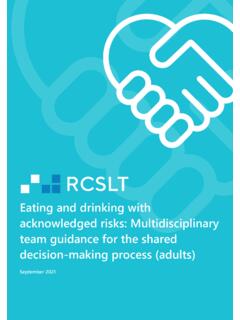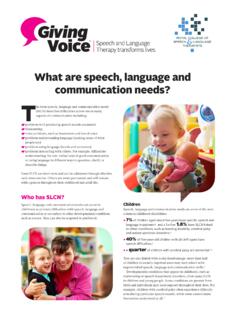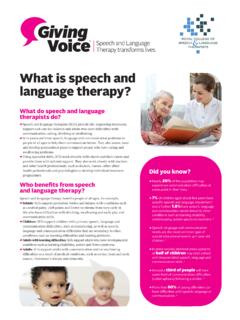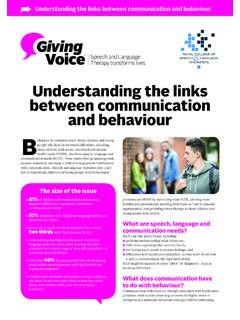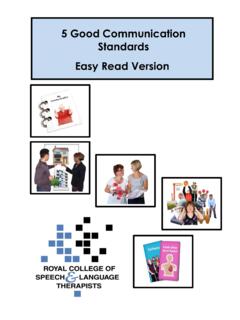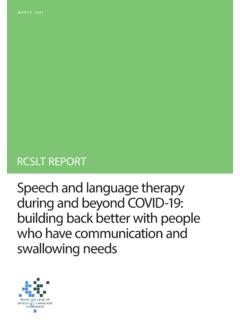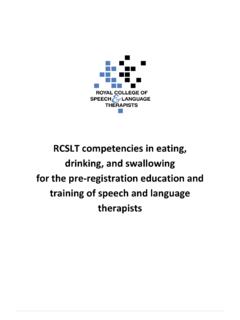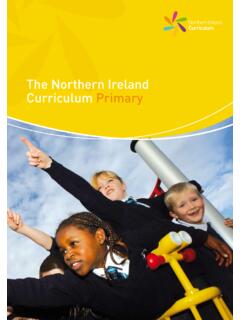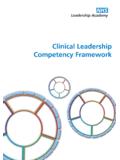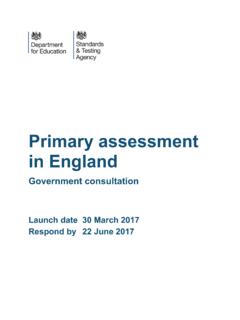Transcription of The links between speech, language and communication …
1 communication provides the foundation for children s development. Early language skills provide the building blocks upon which children s reading skills develop and are a key indicator of educational success and influence life prospects. However, in areas of high social deprivation in the UK, between 40% and 56% of children start school with language ,2 Understanding the linksPoor communication skills are closely linked with social Research shows children living in poverty in the UK suffer disproportionately from language Poverty can strongly reduce parents ability to respond to their child s early language needs and offer a home learning environment that enhances language skills in the early As a group, children from disadvantaged backgrounds more commonly have reduced developmental opportunities that can limit their learning of Why this issue mattersSpeech, language and communication difficulties have a direct impact on children s developmental and educational outcomes, health and wellbeing: Educational achievement.
2 Oral language development is central to a child s ability to access the school curriculum and develop literacy Vocabulary difficulties at age five are associated with poor literacy in adulthood, and children who obtain below the nationally expected level in reading are typically characterised by poor communication , language and literacy Emotional wellbeing and behaviour: children with primary language difficulties are at higher risk of developing behavioural, emotional and social difficulties, which can increase the risk of their exclusion from school and, in the most extreme cases, can lead to young people entering the criminal justice As many as 60% of young offenders are believed to have speech, language and communication needs (SLCN).10 communication in early childhood is key to boosting life chances11 Employability: if left unaddressed, speech, language and communication difficulties can adversely affect children in adult life, for example, poor communication skills affect ,13 88% of long-term unemployed young men have been found to have Social inequality: gaps in language development between children from affluent and disadvantaged families open up as early as three years of Improving language development in the early years is an important tool through which educational and social inequality between social classes can be Cycle of communication deprivation.
3 Failure to address SLCN can encourage an intergenerational cycle of communication deprivation and poor communication skills passed down from parent to child, which can have a detrimental impact upon the child s life The links between speech, language and communication needs and social disadvantage1 Locke A, Ginsborg J, Peers I (2002). Development and disadvantage: Implications for the early years and beyond, International Journal of language and communication Disorders, 37(1), pp. Law J, McBean K, Rush R (2011). communication skills in a population of primary school-aged children raised in an area of pronounced social disadvantage, International Journal of language and communication Disorders, 46(6), pp. All Party Parliamentary Group (APPG) on Speech and language Difficulties (2013). The links between speech, language and communication needs and social disadvantage. Locke A, Ginsborg J, Peers I (2002), op. cit. 5 Law J, et al (2013). Early language delays in the UK, Save the Children: London.
4 APPG on Speech and language Difficulties (2013), op. Snowling M, C Hulme (2012). Interventions for children s language and literacy difficulties. International Journal of language and communication Disorders, 47(1): Johnson, et al (2010). Twenty-year follow-up of children with and without speech- language impairments: family, educational, occupational, and quality of life outcomes. Am J Speech Lang Pathol. 19(1):51-65. doi: (2009/08-0083). Epub 2009 Jul Bryan K, Freer J, Furlong C. language and communication difficulties in juvenile offenders. International Journal of language and communication Difficulties, 2007; 42, 505-520. 11 Law, op. Law, op. cit. 13 The communication Trust (2013). A generation adrift. 14 Elliott N (2011). An investigation into the communication skills of long-term unemployed young men. 15 Save the Children (2014). Read On Get On: how reading can help children escape poverty, London: Save the Children Centre for Social Justice (2014).
5 Closing the divide: Tackling educational inequality in England. Royal College of Speech and language Therapists (2014). RCSLT response to Scottish Parliament Health and Sports Committee Early Years and Health Inequalities Inquiry, March 2014. Document available upon request. 18 Department for Work and Pensions (2014). Households below average income. 19 Scottish Government (2014). Poverty and Income Inequality in Scotland: Social Mobility and Child Poverty Commission (2014). State of the Nation 2014: Social Mobility and Child Poverty in England report summary. northern ireland Statistics and Research Agency (2013). northern ireland Poverty Bulletin 2012-2013. Social Mobility and Child Poverty Commission, op. further information about The Royal College of Speech andLanguage Therapists please visit: AND RESOURCESP olicy solutions In line with the recommendations of the All Party Parliamentary Group on Speech and language Difficulties report regarding the links between social disadvantage and SLCN, the Royal College of Speech and language Therapists is calling upon national and local decision makers to: Provide support in the early years to ensure children from disadvantaged backgrounds have a secure foundation for language and literacy development.
6 Support identification and referral of children with SLCN by: commissioning education and training about children s oral language as part of core speech and language therapy services. ensuring the early years and education workforce has the requisite skills, knowledge, confidence and attitudes to promote language development, and identify and support children with SLCN through initial training and continuing professional development. Support speech and language therapy on social disadvantageAccording to the latest child poverty statistics for 2012-2013: Across the UK: 17% of children ( million) live in relative poverty and 19% of children ( million) live in absolute In Scotland: 19% of children (180,000) live in relative poverty and 20% of children (200,000) live in absolute In Wales: 22% of children (100,000) live in relative poverty and 24% of children live in absolute In northern ireland : 20% of children (approximately 89,000) live in relative poverty (before housing costs) and 22% of children (96,000) live in absolute poverty (before housing costs).
7 21 In England: child poverty rates vary significantly according to region: in the South East 13% of children live in poverty before housing costs and 22% after housing costs. In the North West, 21% of children are in poverty before housing costs and 30% after housing
